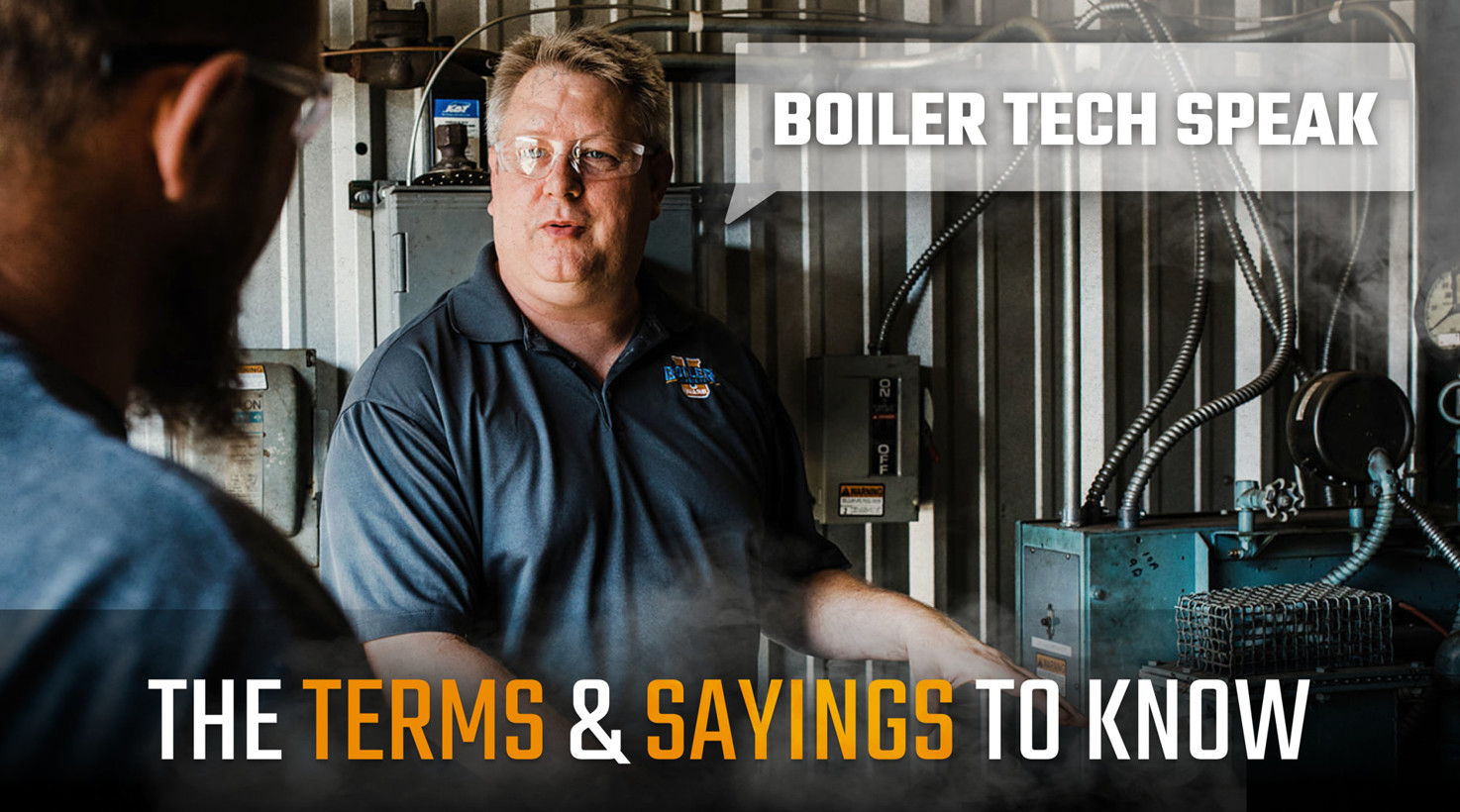WE SPEAK BOILER
The boiler industry has a language all its own. Some of the terms we use may be familiar to people outside our industry, but many might prove confusing to the uninitiated. To help get everyone on the same page, we’ve collected a glossary of terms to help you understand what they mean, and how they play into the entire boiler system.
The first thing to understand is the difference between fire tube boilers and water tube boilers. Remember, boilers are all about transferring heat from combustion into a volume of water. There are two ways you can do that: pass the water through the heat, or pass the heat through the water.
In a fire tube boiler, hot combustion gases pass through metal tubes that run through a boiler’s water tank, transferring heat out of the tube and into the water. A water tube boiler does just the opposite, passing water through tubes that run through a boiler’s fire box so heat can transfer into the tube and the water inside. Now let’s get down to some more specific terms from our industry.
WATERTUBE
Water tubes are found in, you guessed it, water tube boilers. They are hollow metal tubes full of water that pass through a boiler’s fire box. As the water passes through, it absorbs more and more heat from the boiler’s fire box until it has enough heat to change phases and become steam.
FIRETUBE
Fire tubes are found in, drum roll, fire tube boilers. They’re hollow metal tubes full of the hot combustion gases generated in the boiler’s fire box. As the gases pass through the fire tubes, heat is transferred to the water. When enough heat is transferred, the water becomes hot enough to phase-change to steam.
FLEXTUBE BOILER
A flex tube boiler is a type of water-tube boiler that uses a series of smaller, curved tubes rather than large, straight tubes to pass water through the combustion gases. Since they have smaller tubes, flex tube boilers don’t have as much water to heat, so they generate steam faster. What’s more, the curved pathway of the water helps expose more of its surface area to heat, helping it change more rapidly into steam.
TUBE SHEET
The tube sheets are the circular flat plates of metal that hold all the tube ends in place at the ends of the fire tube boiler pressure vessel.
STEAM DRUM
The steam drum, located at the top of the boiler, is the upper pressure vessel component where the water tube boiler’s tubes are connected and steam is collected before it starts its journey through the pipes to its end use.
MUD DRUM
While the steam drum resides at the top of the boiler, the mud drum occupies the bottom. It’s where you’ll find the coldest water in the boiler. It’s also where any impurities, minerals, or other solids in the boiler water will collect.
bLOWDOWNS
Think of blowdown as the water that does the dirty work. When impurities have to be purged or drained from a boiler, blowdown helps carry it out of the system.Think of blowdown as the water that does the dirty work. When impurities have to be purged or drained from a boiler, blowdown helps carry it out of the system.
GAUGE COCK
The sight glass is a glass tube that displays the level of water in the boiler. The gauge cocks are the valves that hold the sight glass in place, and are opened and closed to fill the sight glass when the water level is checked.
WATER COLUMN
The water column isn’t a jet of water shooting out of the top of the boiler. It’s actually the piping that connects the sight glass to the boiler pressure vessel in order to verify water level.
PIGTAIL
A pigtail is a curved piece of pipe coming off the boiler to which a gauge (or sensor) is mounted. Its shape collects condensate to protect the gauge from direct contact to live steam, to prolong the life of the gauge.
FLOAT HEAD
The float head does what its name implies: it holds a float. Specifically, at the water level in the boiler. It’s connected to switches that let the feedwater system know when it’s time to add more water to the boiler.
bULLSEYE
A bullseye is a window into the wonder of a boiler. Literally. It’s a piece of heavy glass mounted in the side of a boiler to let an operator monitor the water level.
SPARGE TUBE
The sparge tube keeps your boiler feedwater preheat system from sounding like a rock stuck in a lawnmower. When hot steam bubbles enter the colder feedwater to preheat it, they implode. The larger the bubble, the louder the implosion. The sparge tube dissipates the steam through small holes, which make smaller bubbles, which, in turn, make smaller implosions.
HAND HOLE
The hand hole is a small access hatch into a boiler. It’s used for cleaning and inspection. It is, in fact, often hand-sized. If you have big hands.
mANWAY
What’s a manway? About 200 pounds on average.No, seriously. The manway is a larger access portal into the inside of a boiler, used for inspection, repair, and cleaning jobs that require people inside.
STAYROD
Boilers work under pressure. Sometimes a lot of it. Stayrods are mounted inside and outside the boiler to reinforce it and keep the pressure from bulging the metal out.
hEADER VALVE
The header valve is where steam begins its trip to work. It’s the valve at the top of the boiler that controls the flow of steam.
Now you’re a little more fluent in boilers. Remember, if there’s anything you don’t understand, we’re here to help. If you’d like to learn more about the inner workings of a boiler, consider taking a few classes at WARE Boiler University. As always, if you need service or maintenance, or a new boiler, we’ve got what you need.
